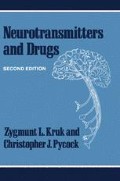Abstract
The idea that nerves may communicate with other cells by releasing small quantities of chemicals at their junctions may have arisen from observations of the effects of poisons on animals. It was found that certain poisons mimic the effects of stimulating certain nerves, and it must have occurred to somebody that nerves release chemicals in response to stimulation. Histological studies showed that there is always a gap between the nerve ending and the target tissue, and that this gap must be crossed if the signal from the nerve is to reach its target.
Access this chapter
Tax calculation will be finalised at checkout
Purchases are for personal use only
Preview
Unable to display preview. Download preview PDF.
Further Reading
Gilman, A.G., Goodman, L.S. & Gilman, A. (1980) The Pharmacological Basis of Therapeutics, 6th edn., Macmillan, New York, Chapters 1,2 & 4
Greengard, P. (1976) ‘Possible role of cyclic nucleotides and phosphorylated membrane proteins in postsynaptic actions of neurotransmitters’, Nature, 260, 101–8
Lamble, J.W. (Editor) (1981) Towards Understanding Receptors, Elsevier Biomedical Press, Cambridge
Lamble, J.W. (Editor) (1982) More About Receptors, Elsevier Biomedical Press, Cambridge
Laurence, D.R. & Bennet, P.N. (1980) ‘Qualitative Pharmacokinetics’, in Clinical Pharmacology, Churchill Livingstone, Edinburgh, Chapter 8
Pycock, C.J. & Taberner, P.V. (Editors) (1981) Central Neurotransmitter Turnover, Croom Helm, London; University Park Press, Baltimore
Rogers, H.J., Spector, R.G. & Trounce, J.R. (1981) ‘Quantitative Pharmacokinetics’, in Textbook of Clinical Pharmacology, Hodder and Stoughton, London, Chapter 1
Schmidt, R.F. (1978) Fundamentals of Neurophysiology, Springer Verlag, New York
Snyder, S.H. & Bennet, J.P. (1976) ‘Neurotransmitter receptors in the brain: Biochemical Identification’, Ann. Rev. Physiol., 38, 153–75
Visi, E.S. (1980) ‘Non-synaptic modulation of transmitter release: Pharmacological implications’, Trends in Pharmacological Sciences, 1, 172–5
Wurtman, R.J., Hefti, F. & Melamed, E. (1981) ‘Precursor control of neurotransmitter synthesis’, Pharmacol. Rev., 32, 315–34
Rights and permissions
Copyright information
© 1983 Zygmunt L. Kruk and Christopher J. Pycock
About this chapter
Cite this chapter
Kruk, Z.L., Pycock, C.J. (1983). Neurotransmission: Sites at Which Drugs Modify Neurotransmission. In: Neurotransmitters and Drugs. Croom Helm Biology in Medicine Series. Springer, Boston, MA. https://doi.org/10.1007/978-1-4615-7517-7_1
Download citation
DOI: https://doi.org/10.1007/978-1-4615-7517-7_1
Publisher Name: Springer, Boston, MA
Print ISBN: 978-0-7099-1530-0
Online ISBN: 978-1-4615-7517-7
eBook Packages: Springer Book Archive

